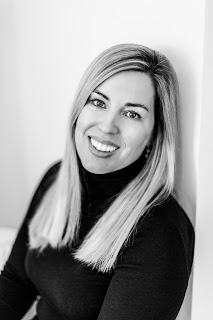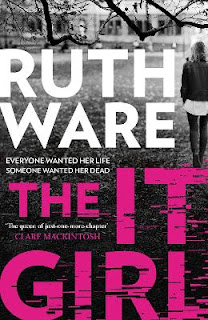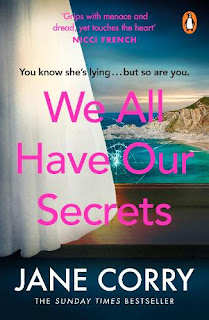Meet Sarah Pearse Author of The Sanatorium
Reese Witherspoon described The Sanatorium as 'An eerie, atmospheric novel that had me completely on the edge of my seat' and we're delighted to welcome its author, Sarah Pearse, as this week's Thriller women interviewee!
The ebook is available from Amazon or you can buy the paperback from Thriller Women's list at Bookshop.org. NB: if you buy books through this link we may earn a commission from bookshop.org, whose fees support independent bookshops.
The Sanatorium is published this week and Sarah told TW all about her love of gothic fiction, her time living in Switzerland, advice for wannabe writers and what it was like getting that phone call from Reese's book club ...
TW: You've chosen to write a gothic thriller - why so?
SP: I’ve always enjoyed reading gothic fiction, so it was a natural step to try and write a gothic thriller of my own. Everything about the genre is so compelling - the innate mystery and suspense, the emotional highs and lows you experience alongside the characters, but I find the visceral atmosphere evoked in a gothic novel particularly exciting. I love how the setting, whether an old building or a castle, or the natural world itself, is used as another character to slowly dial up the creeping sense of tension within the narrative.
When I first read about the legacy of sanatoria in the Swiss Alps, I knew I’d found the perfect setting in which to try and do the same. The cold, clinical nature of the architecture of sanatoria and their history, together with their isolated setting in the mountains, lends itself to creating a wonderfully atmospheric environment in which to set a gothic novel.
The thriller aspect came about as I am a big reader of thrillers in general – I find myself increasingly drawn to a pacy, page turning read with a strong plot (I find that with young children I need a book that holds my attention even after being interrupted multiple times!) so I thought combining this with the atmospheric nature of a gothic novel could work really well.
TW: What was your inspiration for The Sanatorium?
SP: While living in Switzerland, in both Geneva and Crans Montana, I became immediately drawn to the mountains – strikingly beautiful, but also really raw and wild, a combination that I find mesmerising! It’s a stunning place in both summer and winter, but for me, the winter is when it’s at its most dramatic. When the snow starts falling, totally transforming the landscape, you get a real sense of nature’s power and the inherent dangers, and I started thinking that this backdrop would be perfect for fiction.
The idea of setting the novel in a converted sanatorium came about after reading an article in a local magazine about the legacy of tuberculosis sanatoriums in Crans Montana. Sanatoriums were the main driver of people coming in numbers to the town, but when antibiotics became available in the mid-twentieth century, many were converted into hotels, which was the start of the town’s winter tourism industry. This sparked my imagination, and I started thinking about the darker side of this – how would it feel to stay somewhere that had once been a hospital, a place where many people lived and died?
As I researched, I began to think an old sanatorium would be the perfect creepy, gothic setting for a novel. I’m fascinated by repurposed buildings in general and I loved the idea of making the building itself a character within the novel, exploring the idea that the history, the energy and malevolent forces of the past might still be lingering, despite its conversion.
I was also inspired by the architecture of sanatoriums, in particular, how they were often designed according to the principles of ‘functionalism’ - the design and decor optimized to stop the spread of infection and help tuberculosis patients recover (the building itself as a medical instrument.) The design of these buildings were so influential that early 20th Century Modernist architects picked up many key elements of the minimalist design of sanatoria - large windows, balconies to maximise sunlight exposure, clean, smooth surfaces without clutter, floors and walls clear so there were less places for germs to hide.
I began thinking about how this minimalist, clinical design might be used in the hotel and how it would be viewed by a guest – a great way to heighten tension in the novel, especially if some reminders of the building’s clinical past were included within the design.
It was also inspiring that these sanatoriums were often based in remote, high altitude locations - not only for health reasons of being at altitude but in order to stop the spread of infection. I really wanted to use this isolation to put my characters, especially Elin, my detective, under pressure.
Whilst researching, I also learnt about sanatoriums in Switzerland (and elsewhere) for people classed as ‘morally insane.’ In the nineteenth and early twentieth century, many women were placed in medical care for spurious reasons by a male guardian, often diagnosed with ‘Nervenkranke’ (those ill in their nerves). Sometimes this was trickery, a guise to take control of an inheritance, or to suppress independent thought and ideas. Some women spent decades being ‘treated.’ This gave me the idea of exploring this theme within the novel (including with my detective, Elin, and how she is treated because of her emotions) and the echoes with the present day where women are still being judged for their emotions and experiences.
TW: Can you tell us about your road to publication?
SP: It’s been a long and winding road…! Like a lot of authors, I’ve always had a passion for reading and writing and as a child I was constantly writing stories (and creating my own, very amateur newspapers…) and it was my childhood dream to have a book published. I still have a primary school book where I wrote, age five, that ‘I want to be a book writer!’ - I don’t think I’d yet learnt that the word was ‘author’!
My love of words led me onto the English Literature and Creative Writing degree at Warwick University. I loved the course but at that stage wasn’t entirely sure exactly where my writing journey would take me! I still remember one of my lecturers advising us to take time to simply live and experience the world to further develop our writing and I took that to heart. After leaving university, I focussed on a career in procurement and then PR for a large multinational corporation. Even though I was working full-time, I never stopped writing and I had my first short story published while living in Switzerland, which drew me back towards wanting to write full-time. But it was only when I had my daughters and I was on maternity leave that I started to write seriously.
Despite the lack of sleep, I found the time to be creative and I was driven in a new way - to carve out some time for myself in between caring for my daughters. Writing short fiction became both a passion and a welcome distraction from the day to day of changing nappies and getting the baby/toddler to sleep! I went on to have a variety of my short fiction featured in both literary and commercial magazines. Several of my short stories were longlisted and shortlisted for various prizes which was a huge confidence boost and influenced my decision to want to take my writing to the next level.
I then decided to embark on my first novel and sent out my novel to agents. I had three agents offer to represent me, including my brilliant agent, Charlotte Seymour from Andrew Nurnberg Associates, which was thrilling – a real ‘pinch me’ moment! We worked on a novel which didn’t quite work out, but one which I learnt a huge amount from, and shortly afterwards I started writing The Sanatorium. We worked on it for a little while and then sent it out on submission. It was amazing to learn quite quickly that there was interest and received a pre-empt for a two-book deal from Tash Barsby at Transworld just a few weeks later (cue a lot of screaming, crying and everything in between!) A variety of international offers followed soon afterwards, as well as an offer from Pamela Dorman Books in the US. (Cue more crying!) From there, the process has been a whirlwind, but I’ve enjoyed every second. I genuinely find it hard to put into words the very special feeling of having your childhood dream made real!
TW: What's your advice for others wanting to get published?
SP: One word: perseverance! I’ve written so many things, some of which found a home and some which didn’t, but I think it is key not to focus on the ones that didn’t quite make it, and simply see them as progress and part of your writing journey. You learn something with everything that you write so nothing is wasted, and I really believe that if you have an absolute passion for writing and are ferociously determined, you will find your path eventually.
I think publishing can seem like quite a closed world, particularly if you aren’t London based (I live in the South West, far away from anywhere!) and don’t have any connections in the industry, but don’t let that put you off. There are most definitely people who have and use their connections, be it family or friends, there are also lots who have found own way via the ‘slush pile’ as I did, so keep going!
I also think there is something really key in something my tutor at Warwick – that to write, you need to get out there, experience life and use these experiences to develop your voice as a writer.
I truly believe that it is only when you are really inspired or excited by something that you can write from the heart. With both short fiction and novels, you will need to revisit that story multiple times and if you aren’t passionate about it, I don’t think you can maintain the momentum you need to finish the story and create something that will keep move readers and keep them turning the page. Publishing is a business, so it obviously makes sense to look at what is selling and to read widely, but the best story that you will write is the one that you are passionately excited about and invested in.
TW: Who are your favourite gothic thriller writers and books you'd advise readers to read?
SP: I wouldn’t describe these as thrillers necessarily, but they are all brilliantly gothic. Some of my favourites include The Haunting of Hill House by Shirley Jackson, The Woman in Black by Susan Hill, The Little Stranger by Sarah Waters and The Stranger Diaries by Elly Griffiths. I also love Michelle Paver’s Thin Air, which strictly speaking is more of a ghost story, but definitely has elements of the gothic about it, particularly in how the mountain itself becomes such a huge character within the novel, bringing about that creeping sense of unease…
TW: What are your key tips for plotting?
SP: I think believe that having a structure of some kind is key to plotting, as well as developing strong characters. I love books that have a lot of twists and turns and keep the reader guessing and hopefully, turning the page, and plotting in advance really helps me in developing these.
For me, characters are really key to this plotting process. I work on my characters before anything else, honing their backstory and it is this which provides the underpinnings for the plot itself. Unless I know my characters, their motivations and goals, I’m not able to start working on the plot in any way.
I don’t stick to a completely fixed structure while writing though, as I think this would take some of the fun out of the process. Some of the twists in The Sanatorium emerged organically while writing as the characters ‘led me’ into some interesting situations and threw my previous ideas for them on their head. This was really fun and helped keep the narrative fresh and exciting to write.
TW: What's next for you in your career?
SP: I’m in the closing stages of writing my next novel that sees Elin return to her job as detective in another dark and dramatic setting with a complex case that pushes her to the edge in both her personal and professional life. I’m also working on some short stories which I’m loving: I really relish the different challenges that the form presents.
TW: Congratulations on The Sanitorium being a Reese Witherspoon book club pick. How did you hear about this and what does it mean to you?
SP: Thanks so much - the news is still sinking in! I heard about it through my lovely editor in America. We’d just finished having dinner as a family and I got an email from her asking if I could hop on a call together with my agent as she had some news… and that’s when she told me! Cue lots of screams and excitement! The news was huge for me - an absolute dream but something I’d never even contemplated happening to me and my book. It is an absolute privilege being part of this amazing community of authors and readers who have welcomed me with open arms. Reese is hugely inspirational to me, and what she is doing with Reese’s Book Club is very special - championing a diverse range of women’s voices and their stories and changing the narrative for women everywhere - a trailblazer in every sense of the word. I couldn’t be prouder that my book is part of this wonderful community.
Quick fire questions:
TW: Ghosts or unexplained occurrences?
Quick fire questions:
TW: Ghosts or unexplained occurrences?
SP: Unexplained occurrences.
TW: Writing or typing?
TW: Writing or typing?
SP: Typing (then printing and writing – don’t ask, it’s a long and arduous process…)
TW: Halloween or Christmas?
TW: Halloween or Christmas?
SP; Both, possibly on the same day...or even better, both twice a year! I’m a kid at heart!
Arriving in the midst of a threatening storm, Elin immediately feels on edge. Though it's beautiful, something about the hotel, recently converted from an abandoned sanatorium, makes her nervous - as does her brother, Isaac.
And when they wake the following morning to discover his fiancee Laure has vanished without a trace, Elin's unease grows. With the storm cutting off access to and from the hotel, the longer Laure stays missing, the more the remaining guests start to panic.
But no-one has realized yet that another woman has gone missing. And she's the only one who could have warned them just how much danger they're all in . . .
***
Thanks Sarah!
More about The Sanatorium:
An imposing, isolated hotel, high up in the Swiss Alps, is the last place Elin Warner wants to be. But she's taken time off from her job as a detective, so when she receives an invitation out of the blue to celebrate her estranged brother's recent engagement, she has no choice but to accept.Arriving in the midst of a threatening storm, Elin immediately feels on edge. Though it's beautiful, something about the hotel, recently converted from an abandoned sanatorium, makes her nervous - as does her brother, Isaac.
And when they wake the following morning to discover his fiancee Laure has vanished without a trace, Elin's unease grows. With the storm cutting off access to and from the hotel, the longer Laure stays missing, the more the remaining guests start to panic.
But no-one has realized yet that another woman has gone missing. And she's the only one who could have warned them just how much danger they're all in . . .
***
Never. miss a Thriller Women post! Subscribe to the blog (the link is a the top of the page) to receive an email whenever we feature a new must-read author and book. Go on, you know your bookshelves/ereader deserve it.




Comments
Post a Comment